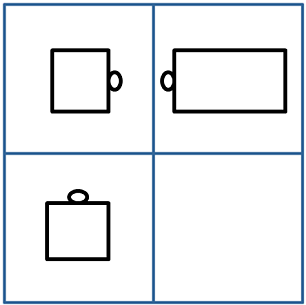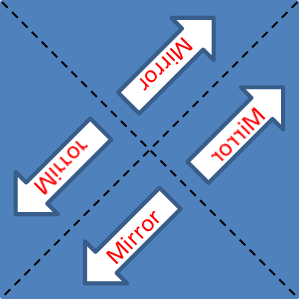The Canadian Cognitive Abilities Test (CCAT 7) is an assessment tool used in Canada to evaluate students' cognitive abilities. The CCAT 7 is used to identify students eligible for gifted and talented programs across Canada. It assesses cognitive abilities through three domains: verbal, nonverbal, and quantitative reasoning
If your child wants to take CCAT 7, prepare them with our fun, interactive online CCAT study packs. Get hundreds of CCAT questions and full-length practice tests.
Free CCAT Sample Questions
Below, you will find a collection of question examples from the Canadian Cognitive Abilities Test. This test is divided into three parts or batteries: Verbal Battery, Quantitative Battery, and Non-Verbal Battery. Each battery has three different question types. To help you understand the format and style of the test, we will provide a sample question from each battery.
The Verbal Battery assesses a student's ability to understand and reason with language.
CCAT Test: Verbal Battery
Verbal Analogies: This question type tests a student's ability to recognize relationships between words. Students are presented with a pair of related words and must identify a similar relationship among another set of words
CCAT 3rd Grade Practice Question-Verbal Analogies
The first pair of words are related in a certain way. Choose the word that completes the second pair of words so that they are related in the same way.
Brain → think : nose →
Get more CCAT test practice
Sentence Completion: This subtest evaluates a student's ability to understand context and vocabulary. Students are given a sentence with a missing word and must choose the most appropriate word to complete
CCAT 4th Grade Practice Question-Sentence Completion
Choose the word that best completes the sentence.
Jake ______ the other kids who had fun at summer camp while he stayed home for the summer.
Verbal Classification: Students are presented with a list of three words that share a common characteristic. They must then select a word from the choices that belong to the same category
CCAT 5th Grade Practice Question-Verbal Classification
Choose the word that best fits with the group:
horizontal vertical parallel
CCAT Test: Quantitative Battery
The Quantitative Battery measures a student's mathematical reasoning and problem-solving skills.
Number Analogies: Students are required to identify relationships between pairs of numbers and apply that relationship to find a missing number in another pair
CCAT 3rd Grade Practice Question-Number Analogies
[44 → 22] [24 → 12] [30 → ?]
Number Series: Students are presented with a sequence of numbers and must identify the pattern to determine the next number in the series
CCAT 4th Grade Practice Question-Number Series
What number comes next in the series?
10 1 9 2 8 3 7 4 6 ?
Number Puzzles: This subtest assesses a student's ability to understand numerical relationships and perform basic arithmetic operations
CCAT 5th Grade Practice Question-Number Puzzles
Solve.
25 = ? ÷ 5
CCAT Test: Non-Verbal Battery
The Non-Verbal Battery evaluates a student's ability to reason and solve problems using geometric shapes and figures, without relying on language skills.
Figure Matrices: Students are presented with a matrix of shapes with one missing. They must identify the pattern and select the shape that completes the matrix
CCAT 3rd Grade Practice Question-Figure Matrices
Choose the picture that belongs with the bottom picture in the same way the pictures on top belong together.

Paper Folding: This subtest assesses spatial reasoning. Students are shown a series of images representing a paper being folded and hole-punched, and must determine how the paper will look when unfolded
CCAT 4th Grade Practice Question-Paper Folding
The paper is being folded and punched with holes. Choose the answer choice that depicts the paper after it is unfolded.

Figure Classification: Students are given a set of figures and must identify which figure does not belong based on certain characteristics or rules
CCAT 5th Grade Practice Question-Figure Classification
The given shapes have a certain pattern. Choose the answer choice that follows the same pattern.

Improve Your CCAT Test Score
Explore our name of CCAT Packs that include
Realistic Simulations
PrepPacks tailored to accurate test scenarios.
Interactive Tests
Practice materials, designed to help students perform their best on their tests!
Premium Quality
Expert-crafted practice tests with accurate questions and explanations
What Is the Canadian Cognitive Skills Test?
The Canadian Cognitive Abilities Test (CCAT) is a cognitive test that is often used for admissions to gifted programs throughout Canada. It is described as the Canadian version of the CogAT Test. The test is published by Nelson Education. The CCAT 7 is the latest version of the test. The CCAT is available to students from grades K–12.
The test has three sections, called batteries. Each battery has three sections, each lasting 30 minutes.
- Verbal Battery: Tests vocabulary through verbal classification, sentence completion, and verbal analogies.
- Nonverbal Battery: Evaluates spatial reasoning through paper folding, figure classification, and figure matrices.
- Quantitative Battery: Assesses numerical reasoning through number series, number puzzles, and number analogies.
Each battery can be administered separately or together. The entire assessment takes 90 minutes to complete.
The testing levels of the CCAT 7 are grade-specific, and TestPrep-Online has test prep packs for the following levels:
What is the Difference Between CCAT and CogAT?
The Canadian Cognitive Abilities Test (CCAT 7) and the Cognitive Abilities Test (CogAT) share several key similarities, but note the differences.
Similarities:
- Shared Purpose Both CCAT and CogAT are standardized tests that measure cognitive abilities and are used as admission tools into Gifted and Talented programs.
- Comprehensive Test Structure The tests mirror each other in their three-battery approach.
- These assessments evaluate reasoning skills, problem-solving abilities, and learning potential.
- They can be administered individually or in group settings.
Differences:
- CCAT 7: Primarily used in Canada, with norms specific to Canadian student populations
CogAT: Predominantly utilized in the United States, with national norming based on U.S. demographics - Although the test batteries align in content, there may be minor variations in the specific skills assessed.
CCAT Score Profile
Think of the CCAT score profile like a detailed map of your child's cognitive strengths and abilities. It's not just a simple number, but a comprehensive view of how your child thinks and learns.
The Three Key Components of the CCAT Score Profile
- Overall Ability Score (Stanine Score)
- This is a simple 1-9 scale that shows your child's general reasoning skills
- 5 is average, 9 is the highest
- Helps you understand your child's overall cognitive potential
- Profile Shape Code
- Reveals the unique pattern of your child's cognitive abilities
- Shows how your child performs across different types of reasoning:
- Verbal (language-based)
- Quantitative (math-based)
- Nonverbal (visual problem-solving)
- Strengths and Weaknesses Indicator
- Highlights where your child shines and where they might need extra support
- Helps teachers and parents understand how to best support learning
How Are the CCAT Scores Used?
The CCAT Score Profile Shapes help teachers understand how your child's different thinking skills relate to each other.
The Four Profile Shapes
1. A-Shape Profile: The Balanced Learner
- All three reasoning areas (Verbal, Quantitative, Nonverbal) are similar in strength
- What This Means:
- Your child has consistent cognitive abilities across different types of thinking
- Teachers can focus on overall enrichment
- No single area stands out as significantly stronger or weaker
2. B-Shape Profile: The Standout Skill
- One reasoning area is significantly different from the other two
- What This Looks Like:
- Maybe your child is great at visual problem-solving but struggles with verbal reasoning
- Or excels in math but finds language-based tasks challenging
- Opportunities:
- Leverage the strong area to build confidence
- Provide targeted support for the area needing improvement
3. C-Shape Profile: The Two-Sided Learner
- Two reasoning areas are quite different from each other
- Characteristics:
- One area is a clear strength
- Another area is noticeably weaker
- Action Steps:
- Celebrate the strength
- Create supportive strategies for the weaker area
- Example: Strong in visual reasoning, developing language skills
4. E-Shape Profile: The Extreme Contrast
- A rare and extreme version of the C-shape
- Important Notes:
- Uncommon profile
- Might require additional assessment to rule out testing errors
- Indicates very significant differences between reasoning areas
What is a Good Score on the CCAT Test?
In general, a higher SAS, percentile, or stanine indicates a higher level of performance relative to the normative group. Usually, a score in the 90th percentile or above is considered very good.
How to Prepare for the CCAT 7?
TestPrep-Online offers comprehensive study packs for the CCAT. Look at our CCAT Sample Questions and practice along with your child.
About TestPrep-Online
TestPrep-Online is a leader in test prep. We help students prepare for many types of tests all over the world. Our team of professional test makers and academics is eager to help you succeed on the CCAT.




